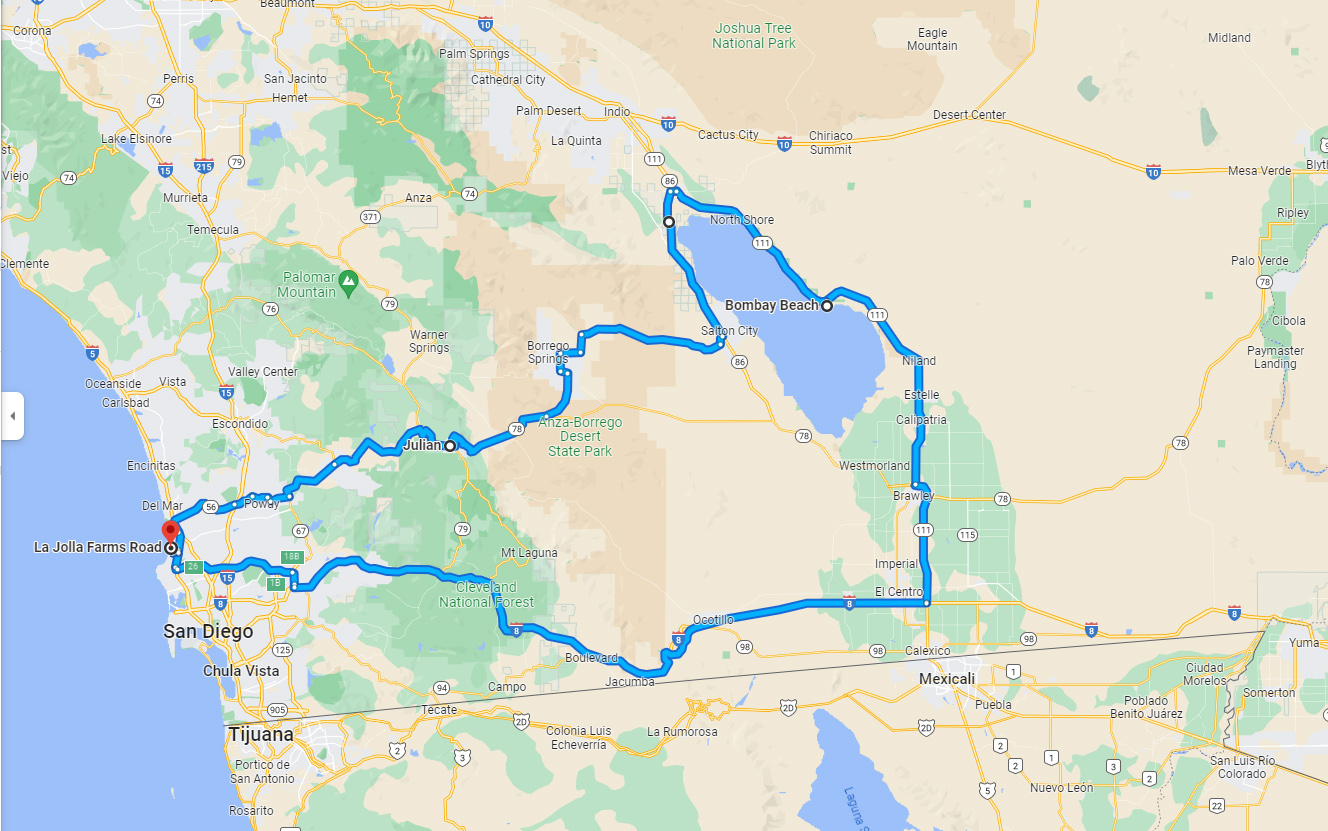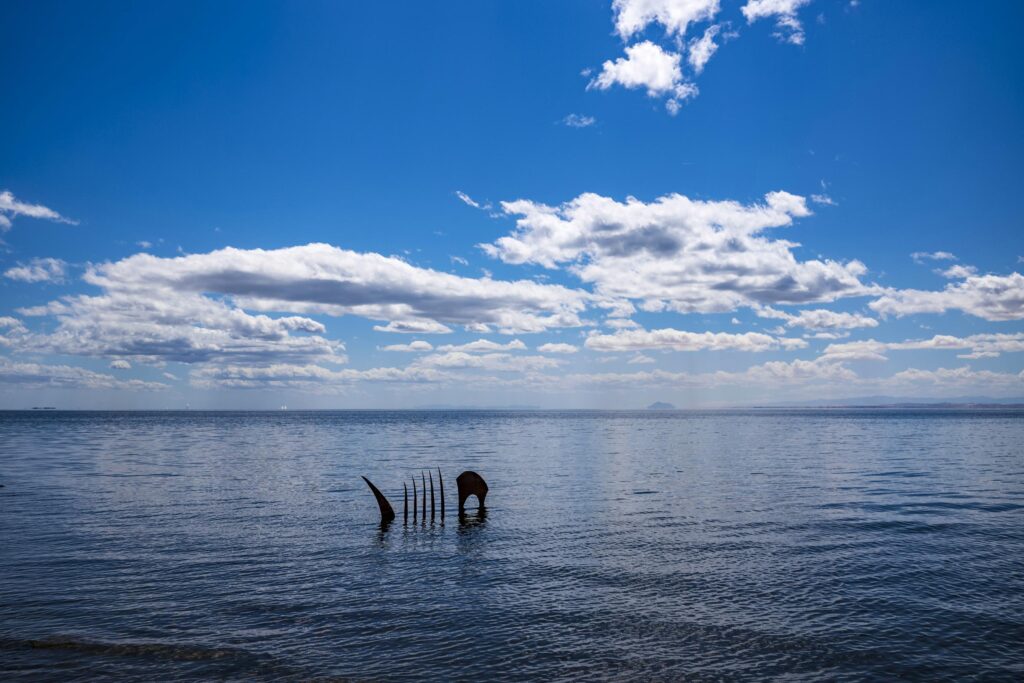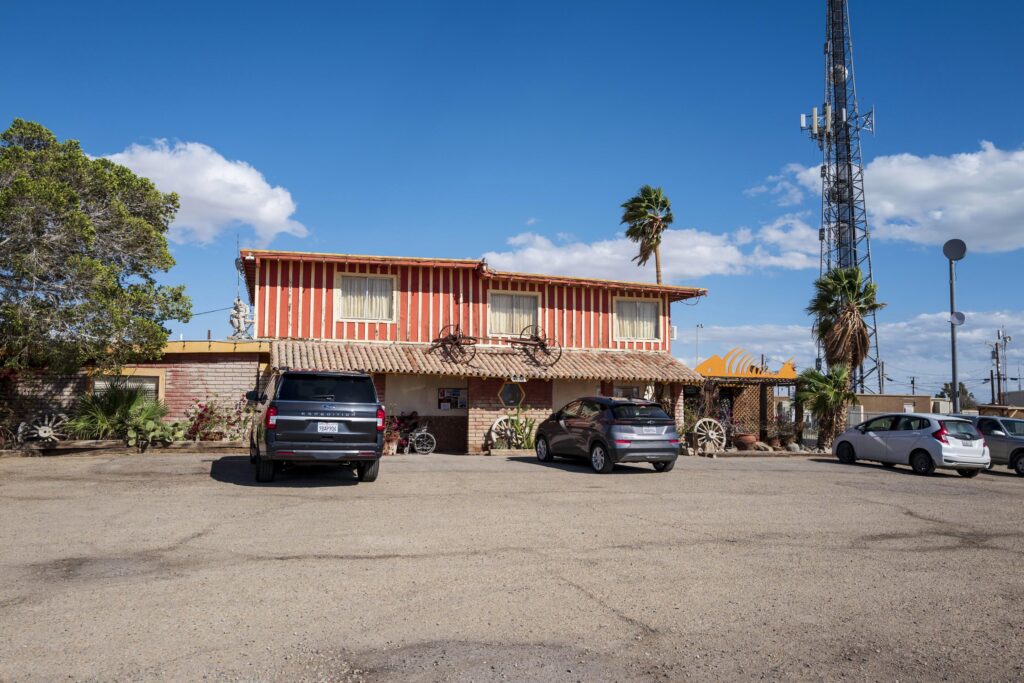California is home to some of the world’s most spectacular areas of natural beauty. Cruising the Pacific coastline, strolling through Redwood forests, or hiking in Yosemite valley reveals nature in all its glory. But the state is also home to a place where nature has been tragically disrupted. Its beauty is of a very different kind, born of dysfunction, decay, and desolation. It is a window into the post-apocalyptic world that awaits us unless we become better stewards of our environment. Welcome to Bombay Beach.
Don’t wake me for the end of the world unless it has very good special effects.
Roger Zelazny
“Don’t wake me for the end of the world unless it has very good special effects.” ― Roger Zelazny
It rains in Southern California
We are regular visitors to Southern California. Contrary to the assertions of Albert Hammond, it rains occasionally. So, on a recent trip, we travelled to Bombay Beach on the Salton Sea to escape the winter season rain in San Diego. We had learned of the place from searching for spots worth visiting and photographing.

As you can see from the map, our counter-clockwise route took us over the mountains to the Imperial Valley. We began our journey in pouring rain, ran into snow at the summit and finally reached warm spring sunshine.
On reaching El Centro, we headed North. The landscape was rural farmland with the typical Alfalfa fields and grain lifters. Before long, we reached the shores of the Salton Sea.
The Salton Sea
The lake was formed between 1905 and 1907 after a dam broke on a canal on the Colorado River. Just imagine: because of pure sloppiness, for almost two years, the entirety of the river ran into a low-lying depression in the northern Imperial Valley.
Sitting at over 220 ft (almost 70 m) below sea level, with an area of 890 km² or 343 square miles, the lake is still the largest in California.
Its location, the Imperial Valley, is, in my opinion, one of the most inhospitable places imaginable. It rarely rains and becomes unbearably hot in summer. Daily maximum temperatures of over 45 °C, 113 °F are practically standard. Despite this, as an alluvial area of the Colorado River, it is intensively used for agriculture. Irrigation water is taken from the once powerful river. Downstream in Mexico, it is a slender trickle, no longer even forming an estuary.
In the 50/60/70s, the lake was one of the hot getaway spots for the greater Los Angeles area. The list of celebrities who spent time there is a who’s who of the movie industry of that era.
However, the lake has no outlet. The brutal summer temperatures referred to above result in extensive evaporation, leading to relentless salinization. The few tributary rivers transport increasing amounts of fertiliser residues into the water body. In addition, there are high concentrations of selenium in the soil and dust.
On the north shore at Mecca are huge date palm plantations. The trees stand in precise lines, as if on a Russian parade ground.
The annual rate of fish death (important for the ecosystem, no kidding) and resulting stench, along with perennial dust storms, made the area highly unattractive. The towns around the lake, except for the northern shore, are mostly abandoned and exude the charm of a gigantic lost place.
Bombay Beach
We reached the sign for Bombay Beach after driving around halfway along the east shore of the lake. We drove by a grim-looking eatery and entered a collection of trailer park houses, regular houses and heaps of rusting metal and furniture in various stages of decay. There was Graffiti everywhere. Bombay Beach gives you an idea of what a post-apocalyptic Earth might look like. Scenes from Mad Max could have been filmed here.
At an altitude of -68 m, -223 ft, the remaining residents occupy the lowest-lying community in the country. The population of Bombay Beach has declined steadily, dropping to as low as 231 residents in 2020. Homeowners tend to drive electric golf carts because the nearest gas station is twenty miles away. It has a single bar/restaurant, the incongruously named “Ski Inn”, and lots of abandoned-looking homes and trailers. It is virtually impossible to tell which of the home sites are inhabited and which are not.
As we walked around the dusty roads searching for the beach, a strange dog came charging for us. We escaped to the safety of the car. So did a family that had followed us.
Spooky action at a distance
Later, we drove slowly through the town over its dusty dirt roads. We caught glimpses of moving curtains when passing by. It was undoubtedly a spooky place: one thing if visiting a theme park, quite another if living there.
Adjacent to the beach and the former harbour is a zone of funny, sad and sarcastic installations. A biennial, attracting a diversity of artists, is usually held in spring but was cancelled due to the pandemic.
Most certainly, the COVID-19 restrictions have not contributed to the prosperity of the place. Some of the residents are probably only here to this day because they lack the resources to move. The place is often referred to as a living ghost town. Nevertheless, some people seem to enjoy hanging out at the beach.
The Ski Inn at Bombay Beach
We explored the area of the former port and then had a burger at the Ski Inn. In fact, this is the only place you can get a beer and a burger. They were out of fries, which would usually accompany the burger. We were grateful to be spared the temptation of sharp-edged, fried-potato rods that can tear your palate open!
We even saw a mouse running over the floor in the establishment. Apparently, we were the only ones who noticed it. Maybe the mouse didn’t know that the French fries were out.
The crowd at the Ski Inn alone was worth photographing.
Urban decay
Fans of Lost Places and Urban Explorers will get their money’s worth here. All others may decide for themselves whether this place is worth a detour. For us, it radiated the fascination of the bizarre and morbid.

The images were taken with Leica Q (type 116), Leica M10 (various lenses), and Nikon D700 infra-red-converted.
Read more from the author
Join the Macfilos subscriber mailing list
Our thrice-a-week email service has been polished up and improved. Why not subscribe, using the button below to add yourself to the mailing list? You will never miss a Macfilos post again. Emails are sent on Mondays, Wednesdays, and Fridays at 8 pm GMT. Macfilos is a non-commercial site and your address will be used only for communications from the editorial team. We will never sell or allow third parties to use the list. Furthermore, you can unsubscribe at any time simply by clicking a button on any email.





























Little YouTube video on the Salton Sea area. Seems to inspire a lot of people:
https://www.youtube.com/watch?v=dzNTfszUW1c
I am late to this article. After reading it, I went to Bombay Beach via Google Map Street View. I would have to agree it looks like some dystopian future.
Definitely food for photographic essays. I thank you for yours..
Hi Dirk, thanks for highlighting this bizarre corner of California with a great set of photos! The state seems to have just about every type of terrain and climate – coastlines, mountains, forests, and deserts. It is sobering to realize that none of these should be taken for granted in a world of climate change and human-made folly. All the best, Keith
Thank you, Dirk for sharing this. I got aware of this very special spot only now. Aesthetically great and at the same time thought-provoking images. In a way, it is a double ecological disaster – first how the lake came into existence and second how it perishes now. For someone who has the luck to live on one of the most beautiful lakes in Europe, this is almost heart-breaking. JP
I really didn’t know there was a community there anymore. My in-laws lived in San Diego and we used to take trips, when we visited them, to the Anza Borrego Desert, and once or twice went to the adjacent Salton Sea. This was probably in the 1990s. We got the sense of hot real estate deals gone sour, of dilapidation, all with the strong overlay of fish putrefying. It seemed a typical scene of the folly of homus californicus. But we did not have people in our pictures I guess because we didn’t look for towns. You have really caught the flavor. One can almost smell it, even in retrospect.
As I type this, Hurricane Hillary is bearing down on the area, and the Salton Sea might possibly get many more years of life!
Great essay!
Ed
Hi Dirk, I passed through Bombay Beach 3 times: 2009, 2012 and 2019. Believe me when I say the place looked really good in 2019 compared to 2009 and 2012. Gentrification is probably too big of a word but there was an influx or artists with multiple new art installations (BBAC, Bombay Beach Drive-In, Bombay Beach Opera House, etc). I haven’t been back since so I am not sure how the pandemic affected this evolution. Did you get a chance to visit Salvation Mountain in Niland as well?
Dear SlowDriver,
We missed the sign pointing us to Salvation Mountain and continued to Bombay Beach.
I did not mention the opera house, because I did not take any images, stupid me.
We’ll see how it will develop down there in the next years.
Greets Dirk
Thanks for this wonderful photographic essay! It’s on my list of places to visit, but not in August! It’s one of those places where you would just love to hang out (probably at the Ski Inn) and photograph residents and visitors, as I’m sure there are more than enough interesting characters to go round. Glad the Q went on the trip.
Hi Le Chef,
It’s a good place for street photos for sure.
Most interesting and well-written report with excellent images!
“Sitting at over 220 ft (almost 70 m) below sea level, with an area of almost 1000 km² or 390 square meters…”
Did you mean “390 square miles”?
You could well be right! I need to check with Dirk, but temporarily I will change it to miles. According to Wikipedia, though, it says the surface area is 343 sq miles/889 km2, so I’ve used these figures.